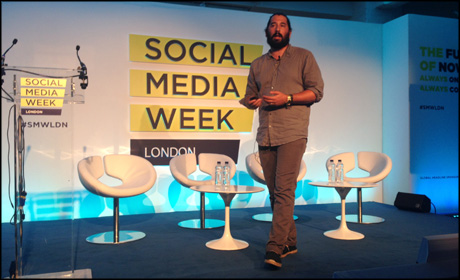
Responsive web design was a buzzword a year or so ago, as publishers took up the challenge of enabling their sites to adapt and respond to different screen sizes.
Now though, this concept has matured into something referred to as "responsive philosophy" which, as the name suggests, incorporates not only technology but also newsroom processes, content and user experiences, according to Dan Gardner, co-founder and executive creative director, UX, Code and Theory.
"Responsive philosophy is taking all context into it, so how it's the right moment for the right user, the right continent, the right time," explained Gardner.
Speaking to delegates at the Social Media Summit in London earlier this week, Gardner noted that over the last 10 to 15 years, news sites have begun to look "all exactly the same".
"It's a rigid homepage," he said, "and every couple of years they re-design, and for that re-design they work through all their internal groups and say 'this is what we need' and bring it down to common denominators and try to deliver on that.
"So every page looks exactly the same, every article template across all publishers the same, they all have the right-hand column, they all have the same problems about how to deliver ads, how to deliver on mobile.
"It's this restrictive template, and really what happens is it limits innovation."
One way for publishers to distinguish themselves, said Gardner, is in how they react and respond to three key challenges – content and experience, technology, and organisational processes.
This is the key concept behind responsive philosophy., he said.
Content and experience
Content and user experience go "hand-in-hand", said Gardner.
"Oftentimes they're separated, but we [Code and Theory] think of them as one – because content obviously delivers on experience and vice versa."
When publishers produce a piece of content such as a story or a video, he said, they should also be thinking about how they can "atomise" that content, or break it down into smaller pieces, in order to use it in different ways and across different platforms.
In order to do this, Gardner said publishers need to ask themselves a few questions: "What is the best experience for this content to live on? What is the format? What is the frequency of publishing?"
Publishers should also take into account information such as user location and what sort of content to deliver at certain times of day.
Personalised and geo-targeted content is already being put into play by organisations such as the Washington Post, and the NYT Now app, which delivers longer reads to users in the evening.
However, Gardner noted that even though media outlets might have enough data on regular users to be able to deliver very specific content, it was important "not to restrict content" in order for users to still be exposed to new things that may be of interest to them.

Code and Theory's Dan Gardner at Social Media Week
Technology
In many organisations technology is treated as a "workaround" said Gardner, put in place to support current practices, rather than treated as something that can enable new creative processes.
One example of an outlet which is using technology to its advantage, said Gardner, is Mashable which created its Velocity tool to predict when a story is about to go viral.
Velocity also powers Mashable's homepage and section pages, deciding which stories to promote and where to display them, although editorial teams can override this if necessary.
The aim, said Gardner, was to reduce the workload of managing different sections of the site in order to focus more on creating content.
"What they want to do is look at social tools and other things to inform content, and spend less time actually managing 'what goes here' and 'what goes there'," he said.
Organisational process
The traditional newsroom set-up, where editorial are quite separate from the development team, which in turn are quite separate from sales and marketing, can act as a barrier to creativity and innovation, said Gardner.
"Oftentimes, in many organisations, you're stuck in these silos," he said. "How do you do creative storytelling when you're stuck in a silo and you only responsible for one aspect of it?"
Code and Theory worked with Hearst to redesign more than 20 magazines, including Cosmopolitan, he said, where one of the key projects was to re-organise the internal workspace.
"Now you have have the tech people working with the writers, and the ads sales and marketing and everything inbetween," he explained.
The LA Times is another good example of an organisation which was really embracing responsive philosophy around content, experience, technology and newsroom processes, he said.
"The newsroom has a meeting every day in which they discuss not only the content, but also the experience," said Gardner. "Everything from 'here's a breaking story, here's an investigative journalism piece I'm doing, this is something that's going to go up in an hour on the homepage, we had much better success when we did this'."
In addition, the outlet has also developed a tool which enables the homepage layout to be altered with minimum effort, sometimes multiple times a day, depending on the content, he explained.
"Making decisions like that is part of the process in the newsroom, and the technology allows [the LA Times] the agility to execute on that within minutes," Gardner said.
Free daily newsletter
If you like our news and feature articles, you can sign up to receive our free daily (Mon-Fri) email newsletter (mobile friendly).









